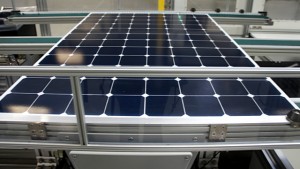Chinese manufacturers of solar panels have been gaining more and more market share. It's not to say that Chinese manufacturers are the only ones. In fact, the largest market share in the US is held by SunPower, which is a US-based manufacturer. But Chinese players have a really big role to play here. And that, in conjunction with a few other things, has resulted in what has become something of a mini "trade war" in the solar industry, headquartered in the US but occurring in other places as well.
This spring we saw the U.S. Commerce Department levy trade tariffs on Chinese solar panels. Are people paying more because of them?
It's been sort of a strange situation because the way that the tariffs worked out in the US, they apply to photovoltaic cell manufacturing. The reason that matters is that the solar panels are basically manufactured in four steps. The cell manufacturing is really the third of four steps. The fourth step is assembling those cells into panels, or modules.
The way that the tariff ruling worked out in the US is: the only thing that really matters is where the cells themselves are manufactured. And the result of that has been that a lot of Chinese manufacturers have essentially started tolling, or having somebody else manufacture their cells for them offshore, most popular being Taiwan, then shipping them back into China, assembling them into modules and sending them to the US, not being subject to the tariff.
So, that does create a cost impact. We estimate it to be something like six or seven cents per watt, which is a little less than 10 percent of the cost of a module, which means there has been a very slight incremental cost impact to anybody who's buying solar panels in the US, but it hasn't been very big. On the scale of a system (we're talking about a panel that costs maybe 80 cents, and a system that costs three or four dollars per watt), a five-or-six cent cost impact isn't huge. So it's had a slight impact, but it hasn't derailed the US market in any major way.
Have the tariffs caused any US installers to stop buying Chinese panels?
I think a lot of them at least opened their eyes to some non-Chinese manufacturers that they wouldn't have before. It did provide an opportunity for them to step in and gain some share where they didn't before, but it did certainly not result in installers in the US stopping using Chinese panels.
How dramatically have solar panel prices dropped in the past few years?
It's been huge. If you look back at even late 2008, panel prices were up close to $4 a watt. Today, they're down in the 70 cent per watt range. So that is an enormous decrease over the course of just four years. And they're continuing to fall.
But there is an important point to make, which is: given how far panel prices have fallen, it becomes less and less important to look for cost reductions from the panel itself. The cost of the solar project isn't just the panel. There's other hardware that gets installed, there's labor, system design, engineering, and financing, and all these other costs, that increasingly are becoming the place where the bottleneck lies in getting costs down.
Are we going to see a big shake-out in the industry?
We're in the midst of a big global solar panel manufacturer shake-out. It's not just true in the US. This year, we have something on the order of about 30 gigawatts of solar demand globally, compared to about 60 gigawatts of solar manufacturing capacity. So there is a huge oversupply, resulting in lowered margins, strained balance sheets for every single solar manufacturer everywhere. We're starting to see this consolidation and shake-out take place. That will be occurring for at least a year and a half before it really settles.
What’s the future like for US solar manufacturers?
It's a tough time to be a solar manufacturer anyway, no matter where you're from. It's particularly difficult to be manufacturing in the US, where your cost structure is going to be higher than it would be if you were in a low-cost location like China, Malaysia, Taiwan, Philippines.
That said, we think the way you can weather the storm is by differentiating in terms of how you're selling into the market. Providing additional services to your customers, doing things like getting into project development yourself. But to be sure, if you cannot weather a very, very difficult storm in which you're not going to be making money for the next 18 months, then you better be looking for a drastic change in your strategy pretty quickly.
We still have a global oversupply. So maybe it (the tariff) provides a bit of an incremental benefit to US solar manufacturers, but it really hasn't fixed the issues that they're facing on a global scale.
Talking about the solar manufacturers these days is kind of depressing, but talking about the solar market in the US is a pretty positive story. Solar deployment remains a positive story, even if solar manufacturing is tough.
